On Saturday October 5th, I found myself sitting on a square bale of straw, surrounded by children, most of which were not mine. I have 11 children of my own, and there were a lot more than that on this beautiful autumn day, laughing and enjoying the sunshine and companionship. An adventure awaited, and the enthusiasm was high.
My straw-bale seat was on a tall old trailer, the second of two trailers hooked up behind a vintage John Deere tractor. By the trailers, an enormous fuzzy brown-and-white cow, heavy with an unborn calf (or two, judging by her girth!), picked at the straw in our seats and rolled it around in her mouth to see if it was better than the fading grass of summer. She was joined by a few other cows, all happy to see the children and share in the excitement.
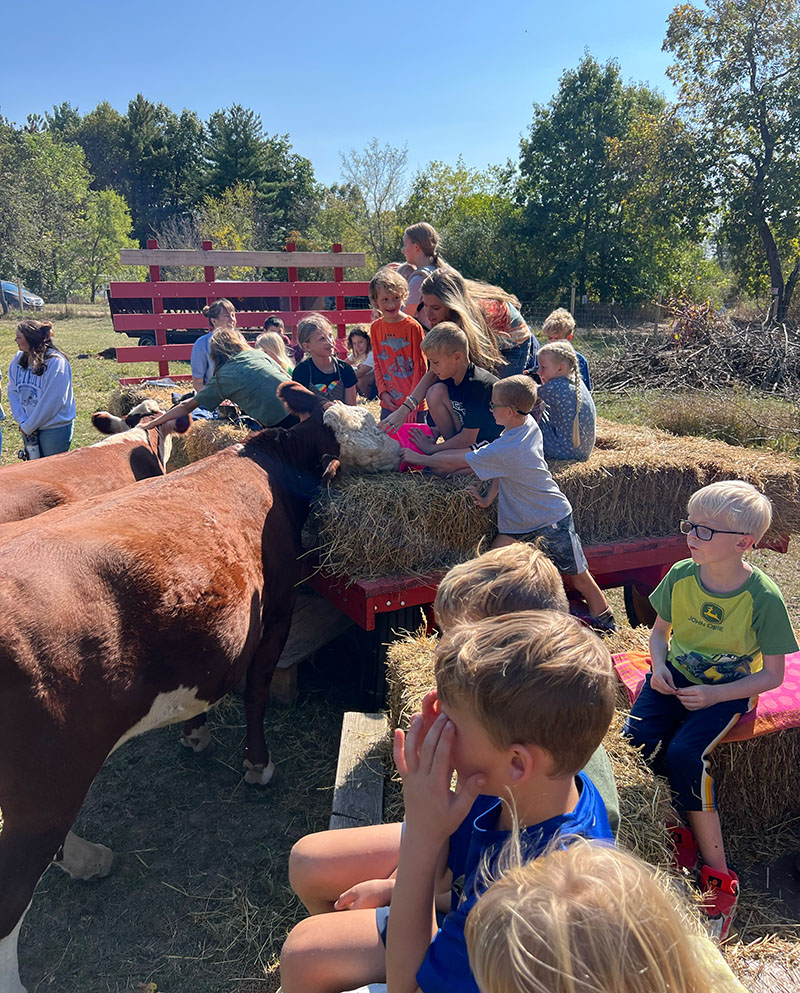
“Hold on, everyone!” at the tractor yelled. “I’m gonna have to roll this thing to start it.”
A moment later, the trailers and the tractor gradually started to roll, then picked up speed, then a swift jerk rocked our trailers and straw-bale seating, followed by the sound of a tractor motor roaring to life.
A Hay Ride Through Michigan Apple Country
We rolled out of the field and onto the county road in front of the farm as kids cheered and adults laughed.
The farm was in Grand Rapids, Michigan – an area well-known for its fruit production. In fact, the region is known as the “Fruit Ridge.”
Fruit Ridge or “the Ridge” is a topographical land feature located NW of Grand Rapids, Michigan and considered to be an agricultural mecca. The glaciers of long ago left behind gently rolling slopes. The deposits were fertile clay loam soils with excellent moisture holding qualities that provided great soil and terrain for the growing of premium fruits, vegetables and the raising of livestock, including buffalo.
Approximately 8 miles wide by 20 miles long, the Fruit Ridge is regarded as one of the prime fruit-growing regions in the world. Elevations greater than 800 feet and its location (about 25 miles from Lake Michigan), creates a unique climate (ideal growing and moderate winters) for fruit production. The Ridge supplies 60% of the states (Michigan) apples. An estimated 66% of the Ridge lies in Kent County, all within 20 miles of downtown Grand Rapids.
A Family Outing
Today’s hay ride was put together by some relatives and friends of our godparents, Kyle and Danielle. They and their six children were also on the ride. Danielle’s brother James was driving the tractor. He is a well-muscled military man, trying to keep the family farm alive with a herd of cows that he is expanding as he has time to care for them.
We rolled down the road, then through a gate and across a rough and overgrown area. As we rolled through it towards a second gate, I spotted a few large apple trees. Despite their bad form, rotten limbs and wild grape and bindweed dreadlocks, the trees were filled with fruit.
As the tractor rolled to a halt before the gate, a few of the children jumped off their trailers and gathered some fresh apples. Then the tractor started rolling again and the kids scrambled back on, apples in hand.
We passed through the gate and into a well-kept orchard… of peaches!
The group of pre-teen girls to my left chattered like squirrels on Red Bull, utterly uninterested in peach trees. My 5th-born son on their other side – a born phlegmatic – looked at me, glanced at the hyper array of femininity, then looked back at me and shook his head in resignation.
Visiting A Modern Apple Orchard
Beyond the peaches, a woman was mowing an expanse of green grass with a tractor and bushhog… and beyond, I finally saw them. A vast orchard of tiny apple trees. Thousands and thousands of apple trees, with fruits of yellow, pink, red, and dark wine.
They didn’t look like the apple trees we’d passed at the gate, however. These apples were planted less than three feet apart in their rows, manacled to posts and wires, standing straight as soldiers and covered with large fruit despite their diminutive size. Each row was separated from the next by 12′ of space. The orchard more resembled a corn field than the orchards of the past.
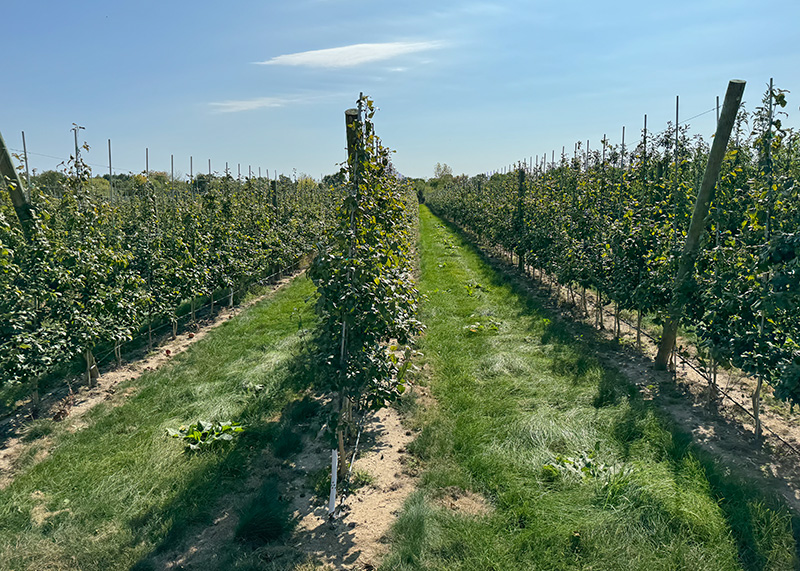
The Wells family owns this orchard, and has kept it for over a hundred years.
I got to talk with Scott Wells, one of the current owners, about their current approach to growing apples. He shared with me that his grandfather had planted trees in a 40′ x 40′ grid, and then later, planted closer, and then closer, as new techniques and root stocks came available. Now, Scott oversees the planting of trees at only 30″ apart inside each row, with a spacing of 12′ between rows.
A modern apple orchard is planted like this:
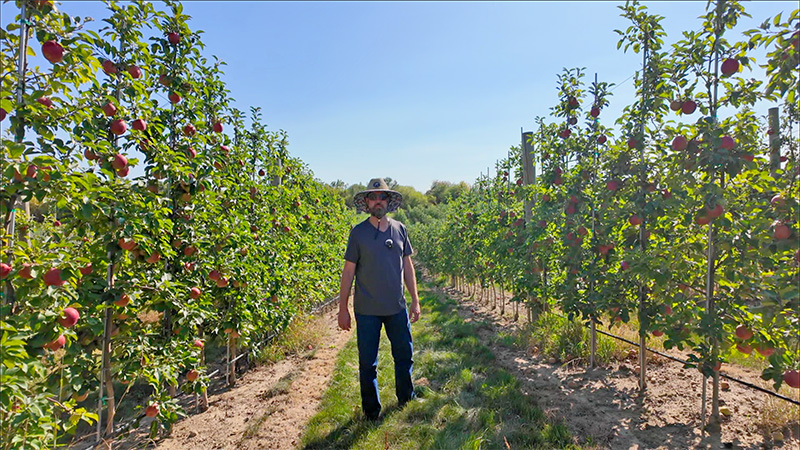
A Look at a Traditional Apple Orchard
After our hay ride (on which a few bushels of apples, ice cream, donuts, adult beverages and a bunch of decorative pumpkins were procured) we came back to the family farm we’d started at. There, Daisy and I hiked out to what was their original apple orchard from long ago. It was an overgrown and run-down mess, but there were still apple trees there, planted way back in the 1930s.
I asked James if he planned to clear out some of the brush, but he told me the deer hunting was simply so good in the orchard that he didn’t want to clear much of it until he was able to really devote himself to the farm. As it was, his military career kept him from all the farming he wished to do, so the apples have to keep fending for themselves for now. When you already have floods of apples, sometimes venison can be tempting.
What a Difference in Spacing!
Look at the spacing between these old trees in a traditional apple orchard, in comparison to the modern plantings at Wells Orchards:
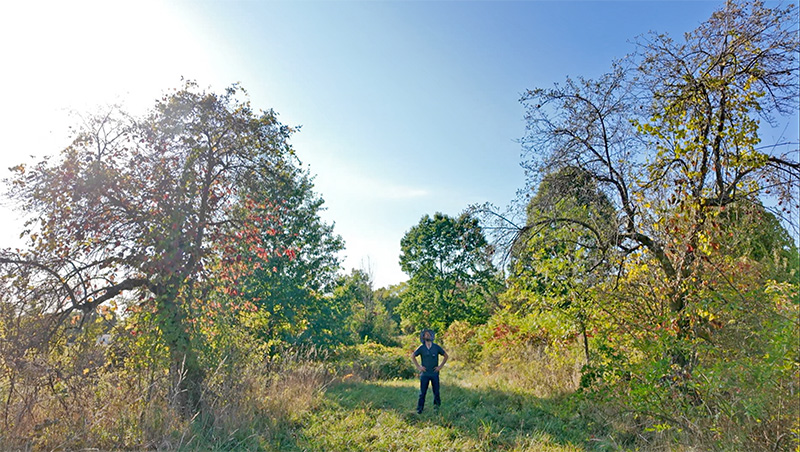
Years ago, these trees produced tons of fruit which was stored in cellars for distribution to grocery stores. Unfortunately, modern times did away with most of the old independent groceries and larger orchards supply the contracts for the Walmarts of the world, so the operation declined and is no longer a commercial venture.
It’s hard to compete with the big guys, and many local apple orchards are no longer functioning. The creep of the suburbs has pressured farmers. It’s a real temptation to give into developers and cash out old family farms for many thousands or even millions of dollars.
Yet many of the old trees still remain as a reminder of past glory, producing their apples for those who care to pick, and for the deer and cows that graze beneath their rugged and ancient limbs.
Old Apple Orchards vs. Modern Apple Production
There are some big differences between modern apple cultivation and the apple orchards of the past, and it goes beyond the spacing.
Modern Apple Production
First, modern apple orchards are using sub-dwarf root stocks for their apples. This means each apple tree has a tiny root system which does not fend for itself very well and requires lots of care and supplemental irrigation. These ultra-dwarf trees also need staking, as winds and even just the weight of their fruit knocks them down like dominos.
On the upside, the trees produce quite quickly on these root stocks. Scott Wells told me their trees often bear in the first year. A standard apple might take a half-decade or more to start bearing fruit.
If you’re willing to baby your apple trees, or perhaps only have a small space, and are looking for high production quickly, you might want to follow the modern orchardists and create a high-density apple orchard.
However, don’t expect that system to last very long. These dwarfed apples need lots of care and have short lifespans. They are the Cornish Cross of fruit trees. Very productive, but completely unable to survive very long on their own – unlike a standard apple tree which may live for centuries. Modern apple culture often relies on cheap immigrant labor, spraying schedules, irrigation, herbicides and more.
Traditional Apple Orchard Production
The old orchards didn’t need irrigation, as the trees could fend for themselves. Full-size apple trees have deep root systems that survive wind, snow, dry summers and neglect for decades. You can graze cows beneath them as well, and if times get tough, you’ll still have apples.
Not all orchards have gone all the way towards high intensity columnar apple planting.
Apple Orchard Examples from Connecticut
As I was researching this article, Timothy Torres in Connecticut wrote me the following, and attached photos:
Here are photos of trees in two local orchards near me.. I learned as much as you could have about my own local produce, I didn’t honestly know that they grew them differently up here! Some are like the old school ones you have there. The photos were taken today (October 9th, 2024) at Lapsley and Woodstock.
Woodstock had the smaller trees supported by wire like yours. They do look much hardier though. there are multiple types of apples grown together at both places. Cortland, Macintosh, Golden Delicious, etc. The much more common trees up here are the larger ones, and people have them everywhere!
This is what Lapsley Orchard’s traditional apple orchard system looks like:
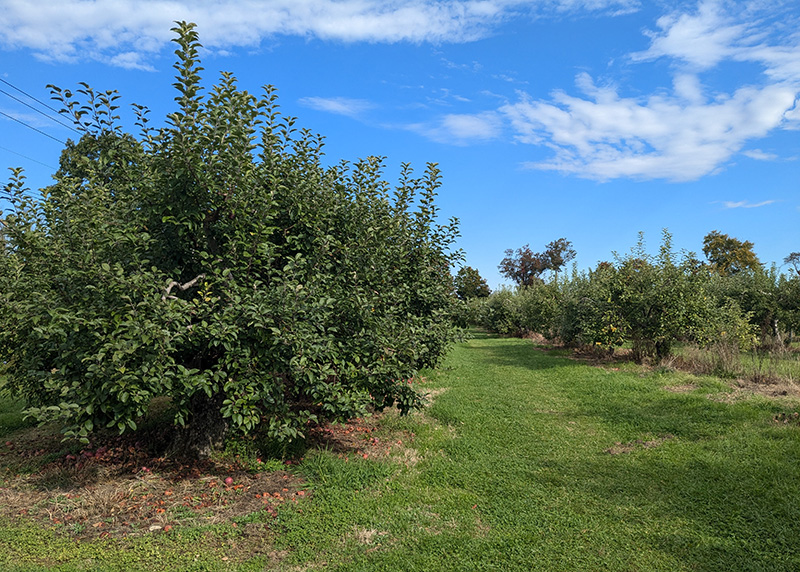
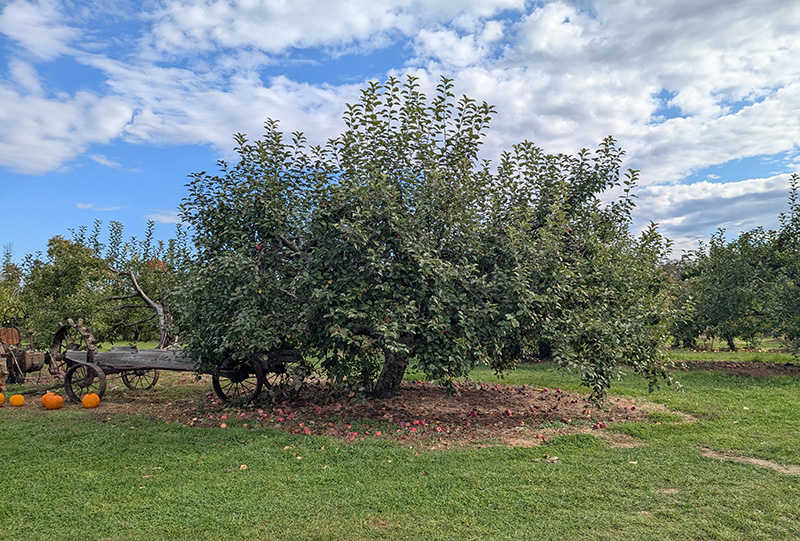
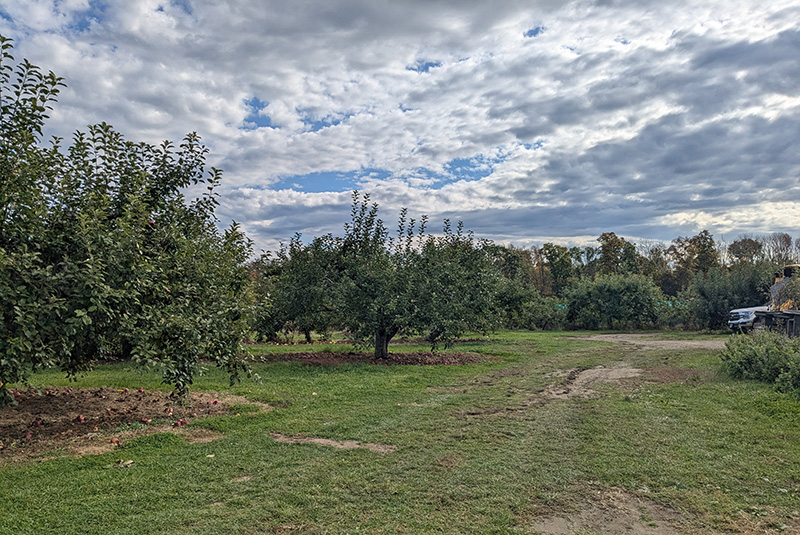
They prune to pickable sizes without wires or stakes. These trees apparently lack irrigation, are widely spaced, and supported by their own roots.
Woodstock Orchards uses closer spacing with wired supports, more like what we saw at Wells Orchards in Michigan:
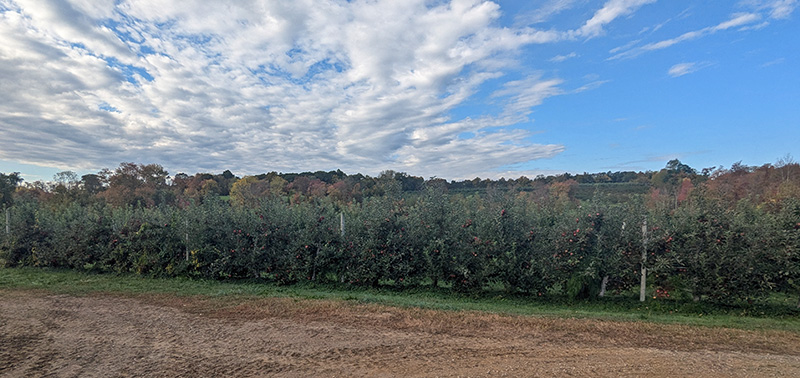
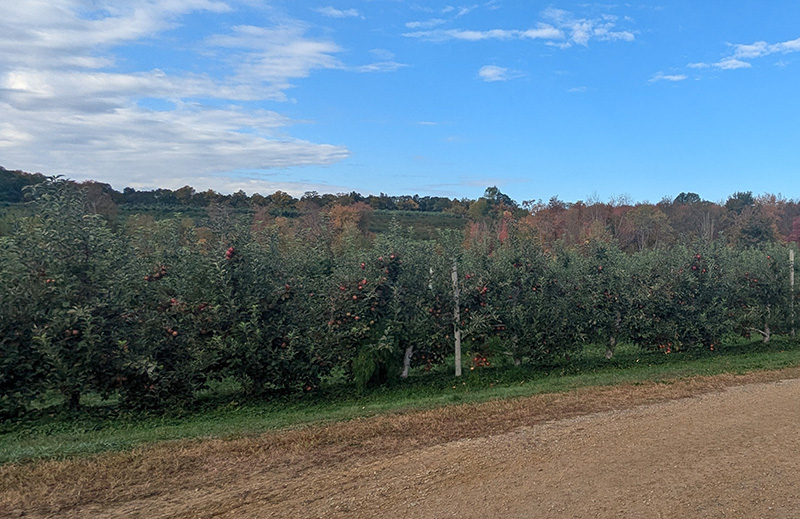
Though wires support these trees, their spacing appears to be at about 6′, and they are not tiny columnar trees.
A Traditional Apple Orchard vs. a Modern Apple Orchards
A permaculture approach to apple growing should use apples that can grow with less human intervention than modern high-intensity growing. There is a trade-off on production in the interest of having self-supporting trees that will live on rainfall after establishment (climate allowing), with deep root systems that can keep trees alive through difficult years and maintaining yields with less work. In a food forest or backyard orchard, having trees that take care of themselves makes sense. Semi-dwarf trees are much tougher than ultra-dwarf types, and standard trees should be the strongest of all, though they take longer to provide yields. An emphasis should also be on growing trees that can grow organically without the need for spraying. Some apple varieties, such as Macintosh, can be high-maintenance due to their susceptibility to disease. Stefan Sobkowiak covers this in his excellent film The Permaculture Orchard.
The Right Apple for the Right Climate
If an apple variety isn’t well-adapted to your climate, it takes more work to grow than a type that can shrug off what your climate throws at it. For example, the “Shell” apple – developed in Brewton, Alabama – produces large fruit and dodges the dreaded fire blight disease common to the Deep South.
Randall White from Flomaton has done good work in identifying and growing multiple varieties of apple in zone 8b, and he has also been researching and talking to expert growers in our region, such as Larry Stephenson:
There are probably apples for your region as well. Some thrive in the north, and some in the south. Some even grow in the tropics. Consider the chill hours of an apple variety, then call your local extension to ask more. Also talk to local nurseries to find the best-adapted types.
Grow varieties that like your climate. Also give the gift of a century of apple pies to your children, grandchildren and great-grandchildren by planting on strong rootstocks.
There’s nothing wrong with setting up high-intensity orchards, but if you leave them to fend for themselves, you will lose your hard work. Old-fashioned apple growing is the more sustainable route, just as growing row gardens is a more anti-fragile way to grow food than using a complicated aquaponics system. I cover this philosophy in my book Minimalist Gardening, and it’s good to keep in mind whatever you’re growing.
How We’re Growing Apples in Lower Alabama
We purchased our homestead in 2022 and started planting apples within months of buying the house.
Apples in the Grocery Row Gardens
In our Grocery Row Gardens, we have some apple trees interspersed with other fruit and nut trees, including pear, chestnut, fig, mulberry, pomegranate and peach. We planted these trees at 12′ spacing inside the rows. We prune twice a year in late winter and around the summer solstice to keep them from overgrowing the rows and shading out the vegetables and fruits beneath them.
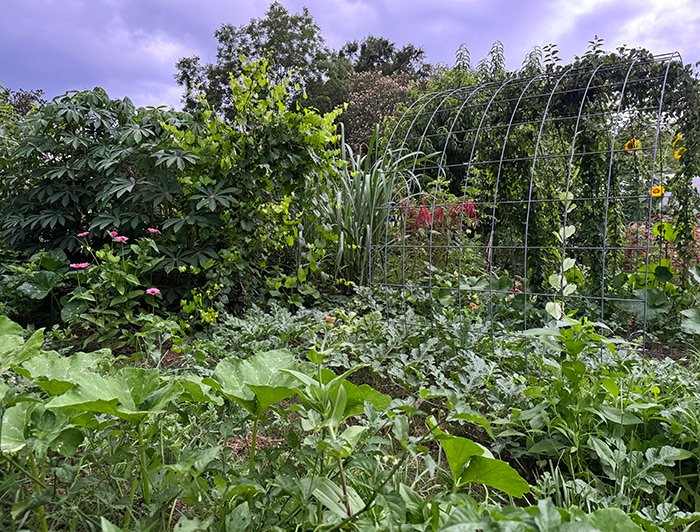
Yes, there are apples in there! Somewhere.
The Mini-Orchard
Further back from the Grocery Row Gardens, we also planted a dozen varieties of Southern apples from Century Farm Orchards. Fireblight killed one of them, and a mismanaged string trimmer killed another, but the others are thriving. We need to get back there and clean up some weeds and grass before winter, but I have hope. They are on semi-dwarf MM111 root stocks. My daughter Daisy painted bricks with their varieties, which we placed at the bottom of each tree. We’re prone to losing track of the varieties we plant – this helps! At some point, I’ll do a proper inventory and list the varieties. Most of them are unfamiliar, old homestead types saved from farms long ago.
Food Forest Apples
In the food forest, we planted a few more apples of different varieties, including some that don’t normally grow in our area such as Honeycrisp and Red Delicious. These are receive little to no pruning or maintenance. We also started some apple seeds from store-bought fruit and will plant those out as well to grow to their maximum heights.
Our plan is to also plant an intense row of apples on a wire, as we saw in Michigan. These will be Shell apples on ultra-dwarf root stocks, and we’ll plant about 20 in a Grocery Row Garden. The space currently hosts Jerusalem artichokes we grew to produce lots of extra tubers for planting elsewhere. Their work is almost done, and it’s apple time.
Plant an Apple Orchard that Works for You
When I was a kid, we visited my Dad’s aunt and uncle on their property in Cherry Hill, New Jersey. Out back they had a huge apple tree that was dropping apples everywhere. They weren’t big fruit, and they did nothing to care for the tree, but they were free and good to eat.
If you have space, try multiple methods. Plant some intensely spaced ultra-dwarf trees and manage them like you’d grow vegetables. Lots of compost and water, with wires to support them. Then you’ll get apples quickly and in abundance, but at the cost of infrastructure and labor. Then find another place to plant some semi-dwarf trees that can live on their own rootstocks with less work and produce apples for you in 5-6 years. Here’s a beautiful picture I found of two women enjoying lunch in an orchard a century ago.
 This could be you!
This could be you!
Finally, if you don’t mind waiting a little longer, plant some standard apples in your yard or food forest. These grow to a stately height and drop hundreds of pounds of apples. All the cider and applesauce you’d ever want, plus bushels for fresh eating and canning. A traditional apple orchard is easy, but a high-production modern system can help get you apples fast.
Plant more than one system, and you’re certain to keep the doctor away.
Unless you eat too many pies – then you might need a dentist instead.
More Resources:
Randall White will be talking about apple varieties for the South at SCRUBFEST III on October 19th – come and join us!
Traditional Southern apple varieties at Century Farm Orchards
Apple Trees for the tropics at Kuffel Creek Apple Nursery
Get the book Grocery Row Gardening
Join our exclusive survival gardening group and get the Start a Food Forest the Easy Way Course as a bonus!

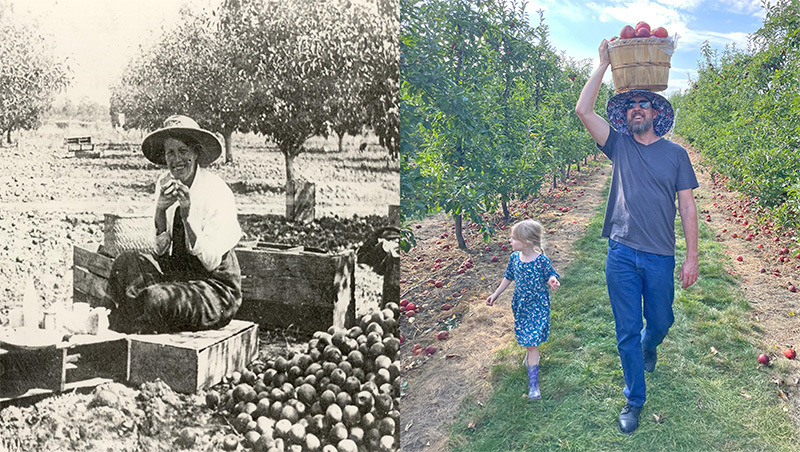
8 comments
I grew up around Gravensteins which are wonderful apples for everything but keeping through winter. The one at my Dad’s house may be over 100 years old. Almost any apple is a good apple if you find a use for it. What I don’t can, cook, dry or or eat, I use to make cider. I hope to hear more of your orchard.
Other online sources for identifying apple varieties:
https://adamapples.blogspot.com/
https://pomiferous.com/
That is super cool. I have heard they are wonderful apples.
I live in Southern Ontario, Canada. Over the past 12 years I have tried to grow apple trees. Each time, the tree lives for a couple of years, bears a few fruits, then mysteriously dies. I’ve tried all kinds of remedies to keep them alive, to no avail. I happen to have several neighbours with many black walnut trees, and some white oak as well. I’ve heard that walnut trees are nasty things to have around if you want to grow anything!
Do you have any insight on this? I’d love to have my own apple tree!
Are there any orchards nearby to give you an idea of what varieties will do well in you area? It can’t be that different from New York state which has lots of apple trees. Is there an agricultural office you can contact to find out if there is particular pest or disease issues in your area?
A couple of years ago, a “feral” apple tree growing in a roadside ditch near the house had a good crop of apples on it so when preparing the fruit for freezing/storage I kept the seeds aside and was able to germinate about 10 by leaving them in pots outside in winter (I live in an alpine region in Australia) and I figured if the original tree grew in the area then its scions should do well too. So far, 9 of the 10 are growing well – 1 died probably from too much shade from gum trees near it – all I’ve done is stake them and put a wire tube of chicken mesh around them to protect them from rabbits. I realise they may well not breed true to the original, the fruit of which resemble a large red delicious but hopefully they’ll be edible, if not, we’ll have some firewood in a few years and in the meantime they’ll help pollinate the existing tree and keep the galahs and cockatoos happy!
I knew modern apple orchards were using dwarf trees at closer spacing. But I had no idea they had gone so far as using columnar trees at 30″ spacing.
The per-acre set-up cost of buying so many grafted trees and all of the irrigation, posts, wire, and labor to set everything up must be astronomical. But I guess the earlier and larger per-acre harvests make up for it.
Great Article as usual. My 2 semi-dwarfs survived the hurricane, no way the columnar apple method would work here. I have a step brother in Washington planting dwarves at 5′ professionally. They are out in the fields every day maintaining the orchards. I rather enjoy just letting mine get to somewhere between 10 and 15′. Still worried that they wont work long term with few chill hours, but I love apples too much not to try.
That’s how I feel too – why not try? Glad your semi-dwarfs made it through. I think that would have destroyed ultra-dwarfs, even if they were tied up.
Comments are closed.